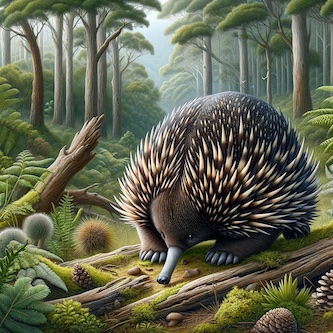A recent expedition led by Oxford University researchers in Indonesia has provided the first-ever footage of the Attenborough’s long-beaked echidna, dispelling fears that the species was extinct. The discovery of this ancient egg-laying mammal, named after Sir David Attenborough, is significant as it had only been known from a decades-old museum specimen. The team also found new species of insects and frogs, as well as healthy populations of tree kangaroos and birds of paradise during the month-long expedition in the Cyclops Mountains.
The Attenborough echidna, along with the western echidna, is considered critically endangered, and previous expeditions had uncovered signs of its existence in the Cyclops Mountains. However, accessing the remotest reaches of the mountains to provide definitive proof of their existence had been challenging. The rediscovery of the echidna and other new species in the region highlights the need for conservation efforts in the Cyclops Mountains, as the area is not currently protected despite its biodiversity.
The treacherous terrain of the Cyclops Mountains, with steep cliffs, venomous animals, and frequent earthquakes, made the expedition challenging. Despite the difficulties, the scientists were able to confirm the existence of several dozen new insect species and discovered an entirely new type of tree-dwelling shrimp and a previously unknown cave system. The team worked closely with local villages, respecting the sacred areas and traditions of the land, and hopes that the rediscovery of the echidna will aid in building the case for conservation in the region.
The elusiveness of the Attenborough echidna has played a role in local conflict resolution, with disputes between community members being resolved symbolically by finding an echidna and a marlin. The rediscovery of this species and the other new findings emphasize the importance of protecting the Cyclops Mountains and its unique biodiversity. The expedition team believes that the Attenborough long-beaked echidna serves as a symbol of the need to protect and conserve the region to ensure the discovery and preservation of its diverse wildlife.
Original news source: First-ever images prove ‘lost echidna’ not extinct (BBC)
Listen
Slow
Normal
Fast
Group or Classroom Activities
Warm-up Activities:
– News Summary
Instructions: Students are tasked with summarizing the article in under two minutes, capturing all the key points: the discovery of the Attenborough’s long-beaked echidna, the significance of the discovery, the biodiversity of the Cyclops Mountains, the challenges faced during the expedition, and the implications for conservation efforts.
– Opinion Spectrum
Instructions: Lay out a spectrum in the classroom representing different opinions on biodiversity conservation. At one end, place ‘Not important at all’ and at the other ‘Extremely important’. Read out different statements related to the article and conservation, and have students physically place themselves along the spectrum according to their opinion. Then ask volunteers to explain their stance.
– Sketch It
Instructions: Divide students into small groups. Assign each group a different element from the article (e.g., the Attenborough’s long-beaked echidna, the Cyclops Mountains, new species found, etc.). Each group must create a quick sketch that represents their assigned element. Afterward, they present their picture to the class and explain how it relates to the article.
– Keyword Taboo
Instructions: Write down key terms from the article (e.g., echidna, biodiversity, conservation, Cyclops Mountains, etc.). Students take turns picking a word and describing it to their peers without using the word itself or five additional taboo words you’ve pre-selected.
– Future Predictions
Instructions: Students discuss and write down their predictions about the future implications of the discovery mentioned in the article. They should consider the environmental, scientific, and cultural impacts. Afterward, have students share their predictions with the class and discuss the likelihood and potential consequences of these outcomes.
Comprehension Questions:
1. What species was rediscovered by the Oxford University researchers in Indonesia?
2. Who is the Attenborough’s long-beaked echidna named after?
3. What other types of wildlife did the research team find during their expedition in the Cyclops Mountains?
4. Why is the Attenborough echidna considered critically endangered?
5. What challenges did the researchers face while accessing the remotest parts of the Cyclops Mountains?
6. How many new insect species did the scientists confirm during their expedition?
7. In what ways did the expedition team work with the local villages?
8. How has the Attenborough echidna played a role in local conflict resolution?
Go to answers ⇩
Listen and Fill in the Gaps:
A recent expedition led by Oxford (1)______ researchers in Indonesia has provided the first-ever footage of the Attenborough’s long-beaked echidna, dispelling fears that the species was (2)______. The discovery of this (3)______ egg-laying mammal, named after Sir David Attenborough, is significant as it had only been known from a decades-old museum specimen. The team also found new species of insects and frogs, as well as (4)______ populations of tree kangaroos and birds of paradise during the month-long expedition in the Cyclops Mountains.
The Attenborough (5)______, along with the western echidna, is considered critically endangered, and previous (6)______ had uncovered signs of its existence in the Cyclops Mountains. However, accessing the (7)______ reaches of the mountains to provide definitive proof of their existence had been challenging. The rediscovery of the echidna and (8)______ new species in the region highlights the need for conservation efforts in the Cyclops Mountains, as the area is not currently protected despite its biodiversity.
The treacherous terrain of the Cyclops Mountains, with steep cliffs, (9)______ animals, and frequent earthquakes, made the expedition challenging. Despite the difficulties, the scientists were able to confirm the existence of several dozen new insect species and discovered an entirely new type of tree-dwelling (10)______ and a previously unknown cave system. The team worked closely with local villages, (11)______ the sacred areas and traditions of the land, and hopes that the (12)______ of the echidna will aid in building the case for conservation in the region.
The elusiveness of the Attenborough echidna has played a role in local conflict resolution, with disputes between community members being resolved symbolically by finding an echidna and a (13)______. The rediscovery of this species and the other new findings emphasize the importance of (14)______ing the Cyclops Mountains and its (15)______ biodiversity. The expedition team (16)______ that the Attenborough long-beaked echidna serves as a symbol of the need to protect and conserve the region to ensure the discovery and preservation of its diverse wildlife.
Go to answers ⇩
Discussion Questions:
Students can ask a partner these questions, or discuss them as a group.
1. What is your opinion on the importance of discovering new species in remote areas like the Cyclops Mountains?
2. How would you feel if a species thought to be extinct was found in a region near you?
3. Do you think it’s important to name newly discovered species after famous people? Why or why not?
4. What are some challenges you think scientists might face when conducting expeditions in treacherous terrains?
5. How do you believe local communities can benefit from scientific expeditions in their area?
6. Do you think the discovery of new species should influence the creation of protected areas? Why or why not?
7. What is your stance on balancing scientific exploration with respect for indigenous traditions and sacred lands?
8. How would you react if you learned that a creature from your local folklore was actually a real animal?
9. Do you like the idea of using wildlife as symbols for conservation efforts? Why or why not?
10. Do you think international collaboration is important in conservation efforts? Why or why not?
11. What is your perspective on the role of biodiversity in resolving local conflicts?
12. How do you feel about the use of modern technology to discover and document new species?
13. Do you believe that the discovery of new species can significantly change our understanding of an ecosystem?
14. How do you think conservation efforts should be prioritized when funding is limited?
15. Do you think that the rediscovery of species like the Attenborough echidna gives hope for other species considered extinct? Why or why not?
Individual Activities
Vocabulary Meanings:
Match each word to its meaning.
Words:
1. expedition
2. echidna
3. endangered
4. biodiversity
5. conservation
6. rediscovery
7. elusiveness
8. treacherous
Meanings:
(a) The action of protecting something from harm
(b) The quality of being difficult to find or catch
(c) Very dangerous or difficult to deal with
(d) The act of finding something again after it was lost
(e) The variety of life in a particular habitat
(f) The state of being at risk of extinction
(g) A journey undertaken by a group of people
(h) A spiny mammal native to Australia and New Guinea
Go to answers ⇩
Multiple Choice Questions:
1. What was the recent expedition in Indonesia led by Oxford University researchers focused on?
(a) Studying the behavior of tree kangaroos
(b) Documenting the life cycle of birds of paradise
(c) Exploring the history of the Cyclops Mountains
(d) Rediscovering the Attenborough’s long-beaked echidna
2. Why is the discovery of the Attenborough’s long-beaked echidna significant?
(a) It confirmed the existence of an ancient bird species
(b) It provided evidence of a new type of tree-dwelling shrimp
(c) It marked the first time a mammal had been named after Sir David Attenborough
(d) It dispelled fears that the species was extinct
3. What is the conservation status of the Attenborough echidna?
(a) Endangered
(b) Vulnerable
(c) Critically endangered
(d) Near threatened
4. What made accessing the remotest reaches of the Cyclops Mountains challenging?
(a) Extreme weather conditions
(b) Political unrest
(c) Treacherous terrain
(d) Lack of funding for the expedition
5. What did the expedition team discover in the Cyclops Mountains?
(a) An entirely new type of tree-dwelling shrimp
(b) Several dozen new insect species
(c) A previously unknown cave system
(d) All of the above
6. How did the team work with local villages during the expedition?
(a) They respected the sacred areas and traditions of the land
(b) They imposed their own rules and regulations on the villages
(c) They ignored the local customs and traditions
(d) They did not interact with the local villages at all
7. What role did the elusiveness of the Attenborough echidna play in local conflict resolution?
(a) Disputes between community members were resolved symbolically by finding an echidna and a marlin
(b) The echidna was used as a symbol of power in local conflicts
(c) The echidna was believed to bring bad luck to the community
(d) The echidna was used as a currency in local trade
8. What does the expedition team believe the Attenborough long-beaked echidna serves as a symbol of?
(a) The importance of studying ancient egg-laying mammals
(b) The need to protect and conserve the region’s diverse wildlife
(c) The significance of remote mountain exploration
(d) The need to develop tourism in the Cyclops Mountains
Go to answers ⇩
True or False Questions:
1. The recent expedition in Indonesia led by Oxford University researchers provided the first-ever footage of the Attenborough’s long-beaked echidna, confirming fears that the species was extinct.
2. The team also found new species of insects and frogs, as well as healthy populations of tree kangaroos and birds of paradise during the month-long expedition in the Cyclops Mountains.
3. The Attenborough echidna is named after Sir David Attenborough and had only been known from a recent museum specimen before the recent discovery.
4. The scientists were able to confirm the existence of several dozen new insect species and discovered an entirely new type of tree-dwelling shrimp and a previously unknown cave system during the recent expedition.
5. The manageable terrain of the Cyclops Mountains, with gentle slopes, harmless animals, and infrequent earthquakes, made the recent expedition challenging.
6. The rediscovery of the echidna and other new species in the region highlights the unnecessary need for conservation efforts in the Cyclops Mountains, as the area is currently protected despite its biodiversity.
7. The Attenborough echidna, along with the western echidna, is considered critically endangered, and previous expeditions had uncovered signs of its existence in the Cyclops Mountains.
8. The elusiveness of the Attenborough echidna has played a role in local conflict resolution, with disputes between community members being resolved symbolically by finding an echidna and a marlin.
Go to answers ⇩
Write a Summary:
Write a summary of this news article in two sentences.
Check your writing now with the best free AI for English writing!
Writing Questions:
Answer the following questions. Write as much as you can for each answer.
Check your answers with our free English writing assistant!
1. What was the primary goal of the Oxford University researchers’ expedition in Indonesia?
2. Why is the discovery of the Attenborough’s long-beaked echidna particularly significant?
3. What challenges did the researchers face during their expedition in the Cyclops Mountains?
4. How did the expedition team engage with local communities during their research?
5. What role does the Attenborough long-beaked echidna play in local conflict resolution, according to the article?
Answers
Comprehension Question Answers:
1. What species was rediscovered by the Oxford University researchers in Indonesia?
The Attenborough’s long-beaked echidna was rediscovered by the Oxford University researchers in Indonesia.
2. Who is the Attenborough’s long-beaked echidna named after?
The Attenborough’s long-beaked echidna is named after Sir David Attenborough.
3. What other types of wildlife did the research team find during their expedition in the Cyclops Mountains?
During their expedition, the research team found new species of insects and frogs, healthy populations of tree kangaroos, and birds of paradise.
4. Why is the Attenborough echidna considered critically endangered?
The Attenborough echidna is considered critically endangered because it had only been known from a decades-old museum specimen prior to this discovery.
5. What challenges did the researchers face while accessing the remotest parts of the Cyclops Mountains?
The researchers faced challenges such as steep cliffs, venomous animals, and frequent earthquakes while accessing the remotest parts of the Cyclops Mountains.
6. How many new insect species did the scientists confirm during their expedition?
The scientists confirmed the existence of several dozen new insect species during their expedition.
7. In what ways did the expedition team work with the local villages?
The expedition team worked closely with local villages by respecting the sacred areas and traditions of the land.
8. How has the Attenborough echidna played a role in local conflict resolution?
The Attenborough echidna has played a role in local conflict resolution, with disputes between community members being resolved symbolically by finding an echidna and a marlin.
Go back to questions ⇧
Listen and Fill in the Gaps Answers:
(1) University
(2) extinct
(3) ancient
(4) healthy
(5) echidna
(6) expeditions
(7) remotest
(8) other
(9) venomous
(10) shrimp
(11) respecting
(12) rediscovery
(13) marlin
(14) protect
(15) unique
(16) believes
Go back to questions ⇧
Vocabulary Meanings Answers:
1. expedition
Answer: (g) A journey undertaken by a group of people
2. echidna
Answer: (h) A spiny mammal native to Australia and New Guinea
3. endangered
Answer: (f) The state of being at risk of extinction
4. biodiversity
Answer: (e) The variety of life in a particular habitat
5. conservation
Answer: (a) The action of protecting something from harm
6. rediscovery
Answer: (d) The act of finding something again after it was lost
7. elusiveness
Answer: (b) The quality of being difficult to find or catch
8. treacherous
Answer: (c) Very dangerous or difficult to deal with
Go back to questions ⇧
Multiple Choice Answers:
1. What was the recent expedition in Indonesia led by Oxford University researchers focused on?
Answer: (d) Rediscovering the Attenborough’s long-beaked echidna
2. Why is the discovery of the Attenborough’s long-beaked echidna significant?
Answer: (d) It dispelled fears that the species was extinct
3. What is the conservation status of the Attenborough echidna?
Answer: (c) Critically endangered
4. What made accessing the remotest reaches of the Cyclops Mountains challenging?
Answer: (c) Treacherous terrain
5. What did the expedition team discover in the Cyclops Mountains?
Answer: (b) Several dozen new insect species
6. How did the team work with local villages during the expedition?
Answer: (a) They respected the sacred areas and traditions of the land
7. What role did the elusiveness of the Attenborough echidna play in local conflict resolution?
Answer: (a) Disputes between community members were resolved symbolically by finding an echidna and a marlin
8. What does the expedition team believe the Attenborough long-beaked echidna serves as a symbol of?
Answer: (b) The need to protect and conserve the region’s diverse wildlife
Go back to questions ⇧
True or False Answers:
1. The recent expedition in Indonesia led by Oxford University researchers provided the first-ever footage of the Attenborough’s long-beaked echidna, confirming fears that the species was extinct. (Answer: False)
2. The team also found new species of insects and frogs, as well as healthy populations of tree kangaroos and birds of paradise during the month-long expedition in the Cyclops Mountains. (Answer: True)
3. The Attenborough echidna is named after Sir David Attenborough and had only been known from a recent museum specimen before the recent discovery. (Answer: False)
4. The scientists were able to confirm the existence of several dozen new insect species and discovered an entirely new type of tree-dwelling shrimp and a previously unknown cave system during the recent expedition. (Answer: True)
5. The manageable terrain of the Cyclops Mountains, with gentle slopes, harmless animals, and infrequent earthquakes, made the recent expedition challenging. (Answer: False)
6. The rediscovery of the echidna and other new species in the region highlights the unnecessary need for conservation efforts in the Cyclops Mountains, as the area is currently protected despite its biodiversity. (Answer: False)
7. The Attenborough echidna, along with the western echidna, is considered critically endangered, and previous expeditions had uncovered signs of its existence in the Cyclops Mountains. (Answer: True)
8. The elusiveness of the Attenborough echidna has played a role in local conflict resolution, with disputes between community members being resolved symbolically by finding an echidna and a marlin. (Answer: True)
Go back to questions ⇧













